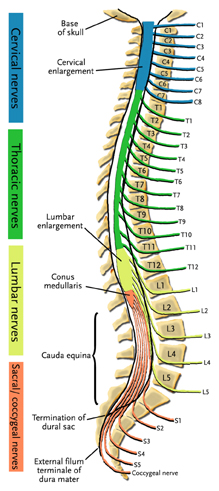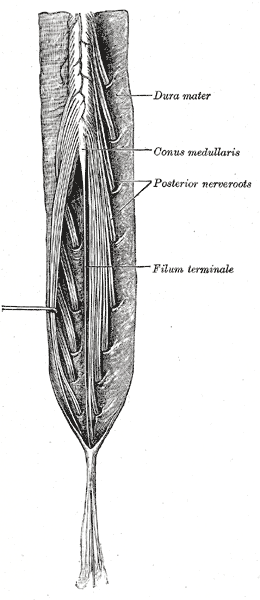Template:Condition: Difference between revisions
Colby Boers (talk | contribs) mNo edit summary |
No edit summary |
||
| Line 2: | Line 2: | ||
'''Original Editor '''- Your name will be added here if you created the original content for this page. | '''Original Editor '''- Your name will be added here if you created the original content for this page. | ||
'''Lead Editors''' - Your name will be added here if you are a lead editor on this page. [[Physiopedia:Editors|Read more.]] | '''Lead Editors''' - Your name will be added here if you are a lead editor on this page. [[Physiopedia:Editors|Read more.]] | ||
</div> | </div> | ||
== [[Image:Colored Spine.jpg|right|This is a picture of the spinal nerves exiting the verterbal column. The nerves are color coded by section]][[Image:Cauda Equina.gif|right|This is a close up picture of the cauda equina.]] == | == [[Image:Colored Spine.jpg|right|This is a picture of the spinal nerves exiting the verterbal column. The nerves are color coded by section]][[Image:Cauda Equina.gif|right|This is a close up picture of the cauda equina.]] == | ||
| | ||
== Clinically Relevant Anatomy<br> == | == Clinically Relevant Anatomy<br> == | ||
| Line 13: | Line 12: | ||
Dengenerative Disc Disease (DDD) is thought to begin with changes to the annulus fibrosis, intervertebral disc, and subchondral bone. The process of degeneration is divided into three classifications including: early dysfunction, intermediate instability, and final stabilization.<ref> Dutton M. Orthopaedic Examination, Evaluation, and Intervention. 2nd ed. New York, NY: McGraw-Hll; 2008.</ref> <br> | Dengenerative Disc Disease (DDD) is thought to begin with changes to the annulus fibrosis, intervertebral disc, and subchondral bone. The process of degeneration is divided into three classifications including: early dysfunction, intermediate instability, and final stabilization.<ref> Dutton M. Orthopaedic Examination, Evaluation, and Intervention. 2nd ed. New York, NY: McGraw-Hll; 2008.</ref> <br> | ||
== Mechanism of Injury / Pathological Process<br> | == Mechanism of Injury / Pathological Process<br> == | ||
Degenerative disc disease refers to a condition in which the involved disc causes LBP. Lumbar degenerative disc disease is usually the result of a twisting injury to the lower back, such as when a person swings a golf club or rotates to put an object on a surface to the side of or behind them. <ref>Ullrich, P. F. (2006 11 6). Lumbar Degenerative Disc Disease. Retrieved 06 02, 2009, from Degenerative Disc Disease: http://www.spine-health.com/conditions/degenerative-disc-disease/lumbar-degenerative-disc-disease</ref><br> | |||
The pain is also frequently caused by simple wear and tear on the spine and comes with the general aging process.<br> | |||
Degenerative disc disease is fairly common, and it is estimated that at least 30% of people aged 30-50 years old will have some degree of disc space degeneration, although not all will have pain or ever receive a formal diagnosis.<ref>Ullrich, P. F. (2006 11 6). Lumbar Degenerative Disc Disease. Retrieved 06 02, 2009, from Degenerative Disc Disease: http://www.spine-health.com/conditions/degenerative-disc-disease/lumbar-degenerative-disc-disease</ref><br><br> | |||
== Clinical Presentation == | == Clinical Presentation == | ||
| Line 21: | Line 24: | ||
People with DDD will have low back pain; however there are varying levels of severity. Pain is often chronic, but one with DDD can experience varying episodes of exacerbation where pain levels are elevated <ref>Ulrich, P. F. (2005, 11 29). Common Symptoms of Degenerative Disc Disease. Retrieved 06 02, 2009, from Degenerative Disc Disease: http://www.spine-health.com/conditions/degenerative-disc-disease/common-symptoms-degenerative-disc-disease</ref> | People with DDD will have low back pain; however there are varying levels of severity. Pain is often chronic, but one with DDD can experience varying episodes of exacerbation where pain levels are elevated <ref>Ulrich, P. F. (2005, 11 29). Common Symptoms of Degenerative Disc Disease. Retrieved 06 02, 2009, from Degenerative Disc Disease: http://www.spine-health.com/conditions/degenerative-disc-disease/common-symptoms-degenerative-disc-disease</ref> | ||
<br> | |||
Activities that typically increase pain include: | Activities that typically increase pain include: | ||
| Line 36: | Line 39: | ||
== Diagnostic Procedures == | == Diagnostic Procedures == | ||
add text here relating to diagnostic tests for the condition<br> | add text here relating to diagnostic tests for the condition<br> | ||
== Outcome Measures == | == Outcome Measures == | ||
| Line 42: | Line 45: | ||
add links to outcome measures here (see [[Outcome Measures|Outcome Measures Database]]) | add links to outcome measures here (see [[Outcome Measures|Outcome Measures Database]]) | ||
== Management / Interventions<br> | == Management / Interventions<br> == | ||
add text here relating to management approaches to the condition<br> | add text here relating to management approaches to the condition<br> | ||
== Differential Diagnosis<br> | == Differential Diagnosis<br> == | ||
add text here relating to the differential diagnosis of this condition<br> | add text here relating to the differential diagnosis of this condition<br> | ||
== Key Evidence == | == Key Evidence == | ||
add text here relating to key evidence with regards to any of the above headings<br> | add text here relating to key evidence with regards to any of the above headings<br> | ||
== Resources <br> == | |||
Dutton M. Orthopaedic Examination, Evaluation, and Intervention. 2nd ed. New York, NY: McGraw-Hll; 2008. | |||
== Case Studies == | == Case Studies == | ||
add links to case studies here (case studies should be added on new pages using the [[Template:Case Study|case study template]])<br> | add links to case studies here (case studies should be added on new pages using the [[Template:Case Study|case study template]])<br> | ||
<div class="researchbox"> | <div class="researchbox"> | ||
== Recent Related Research (from [http://www.ncbi.nlm.nih.gov/pubmed/ Pubmed]) == | == Recent Related Research (from [http://www.ncbi.nlm.nih.gov/pubmed/ Pubmed]) == | ||
<rss>Feed goes here!!|charset=UTF-8|short|max=10</rss> | <rss>Feed goes here!!|charset=UTF-8|short|max=10</rss> | ||
</div> | </div> | ||
== References == | == References == | ||
Revision as of 19:59, 2 June 2009
Original Editor - Your name will be added here if you created the original content for this page.
Lead Editors - Your name will be added here if you are a lead editor on this page. Read more.
[edit source]
Clinically Relevant Anatomy
[edit source]
Dengenerative Disc Disease (DDD) is thought to begin with changes to the annulus fibrosis, intervertebral disc, and subchondral bone. The process of degeneration is divided into three classifications including: early dysfunction, intermediate instability, and final stabilization.[1]
Mechanism of Injury / Pathological Process
[edit source]
Degenerative disc disease refers to a condition in which the involved disc causes LBP. Lumbar degenerative disc disease is usually the result of a twisting injury to the lower back, such as when a person swings a golf club or rotates to put an object on a surface to the side of or behind them. [2]
The pain is also frequently caused by simple wear and tear on the spine and comes with the general aging process.
Degenerative disc disease is fairly common, and it is estimated that at least 30% of people aged 30-50 years old will have some degree of disc space degeneration, although not all will have pain or ever receive a formal diagnosis.[3]
Clinical Presentation[edit source]
People with DDD will have low back pain; however there are varying levels of severity. Pain is often chronic, but one with DDD can experience varying episodes of exacerbation where pain levels are elevated [4]
Activities that typically increase pain include:
- Sitting for extended periods of time
- Rotating, bending, or lifting
Activities that typically decrease pain include:
- Changing positions often
- Lying down
- Staying active[5]
Diagnostic Procedures[edit source]
add text here relating to diagnostic tests for the condition
Outcome Measures[edit source]
add links to outcome measures here (see Outcome Measures Database)
Management / Interventions
[edit source]
add text here relating to management approaches to the condition
Differential Diagnosis
[edit source]
add text here relating to the differential diagnosis of this condition
Key Evidence[edit source]
add text here relating to key evidence with regards to any of the above headings
Resources
[edit source]
Dutton M. Orthopaedic Examination, Evaluation, and Intervention. 2nd ed. New York, NY: McGraw-Hll; 2008.
Case Studies[edit source]
add links to case studies here (case studies should be added on new pages using the case study template)
Recent Related Research (from Pubmed)[edit source]
Extension:RSS -- Error: Not a valid URL: Feed goes here!!|charset=UTF-8|short|max=10
References[edit source]
References will automatically be added here, see adding references tutorial.
- ↑ Dutton M. Orthopaedic Examination, Evaluation, and Intervention. 2nd ed. New York, NY: McGraw-Hll; 2008.
- ↑ Ullrich, P. F. (2006 11 6). Lumbar Degenerative Disc Disease. Retrieved 06 02, 2009, from Degenerative Disc Disease: http://www.spine-health.com/conditions/degenerative-disc-disease/lumbar-degenerative-disc-disease
- ↑ Ullrich, P. F. (2006 11 6). Lumbar Degenerative Disc Disease. Retrieved 06 02, 2009, from Degenerative Disc Disease: http://www.spine-health.com/conditions/degenerative-disc-disease/lumbar-degenerative-disc-disease
- ↑ Ulrich, P. F. (2005, 11 29). Common Symptoms of Degenerative Disc Disease. Retrieved 06 02, 2009, from Degenerative Disc Disease: http://www.spine-health.com/conditions/degenerative-disc-disease/common-symptoms-degenerative-disc-disease
- ↑ Ulrich, P. F. (2005, 11 29). Common Symptoms of Degenerative Disc Disease. Retrieved 06 02, 2009, from Degenerative Disc Disease: http://www.spine-health.com/conditions/degenerative-disc-disease/common-symptoms-degenerative-disc-disease








